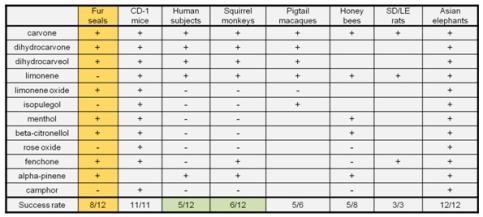Discussions

The '+' indicates success in discriminating and '-' indicates failure. Blank cell indicates no test conducted.
Comparison with other species
- In general, the fur seals’ performance is not poorer than that of the other species (rather, better than that of human subjects and squirrel monkeys).
- All species tested so far succeeded in discriminating between enantiomers of carvone, dihydrocarvone, dihydrocarveol, alpha-pinene. Only fur seals failed with enantiomers of limonene.
Enantiomers in the chemical environment of the fur seals
- Recent studies support the hypothesis that the olfactory capacity of a species may be affected by its chemical environment. When the fur seals’ natural chemical environment is considered, the result of the present study is surprising, given that the enantiomeric odor pairs used in this study are mostly found in essential oils of vascular plants such as oranges and pines which are not common in the environment of fur seals. However, only little is known about the chemical composition of the marine and terrestrial environments inhabited by fur seals.
- The enantiomers that were tested in the present study are all plant-derived, and thus unlikely to be prominent in the marine environment. Nevertheless, the possibility cannot be entirely excluded that enantiomeric odorants exist in the fur seals’ chemical environment. Enantiomeric odorants might also be produced by the fur seals themselves and might serve a function in a behavioral context such as social communication so that they have developed olfactory capacity to distinguish between them.
- Therefore, further studies on enantiomeric substances in a broad range of chemical environment such as the marine, the terrestrial, and the body of fur seals should be conducted to corroborate the results of the present study.
Conclusions
- South African fur seals display well-developed olfactory discrimination ability with eanantiomeric odor pairs.
- Comparisons with other species show that the fur seals at least performed better than human subjects and squirrel monkeys.
- The sense of smell may play an important and traditionally underestimated role in regulating the behavior of fur seals.
Responsible for this page:
Director of undergraduate studies Biology
Last updated:
04/22/12
